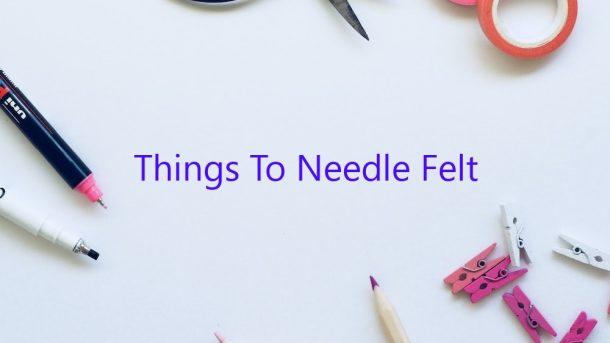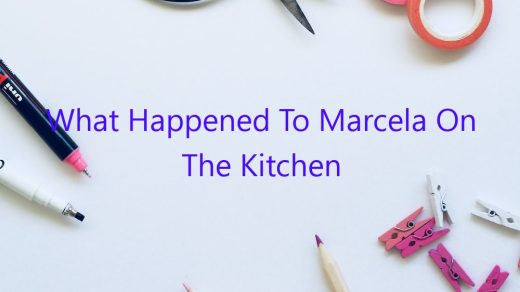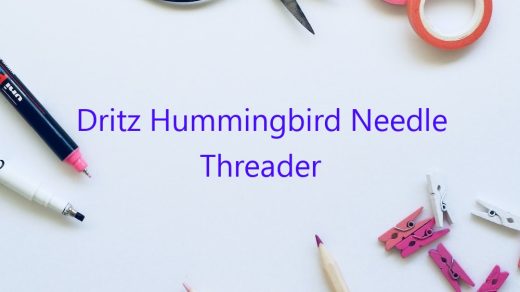Needle felting is an easy, fun, and versatile craft that can be used to make a variety of different items. In order to get started with needle felting, you will need a few supplies.
The first thing you will need is some wool. You can use any kind of wool, but I find that natural fibers work best. You can buy wool roving or yarn, or you can collect it from old sweaters or blankets.
Next, you will need a felting needle. These can be purchased at most craft stores.
Finally, you will need some foam or batting to use as a cushion. This is optional, but it will make your work a lot easier.
Once you have these supplies, you’re ready to start needle felting!
Contents [hide]
What can I needle felt on?
Needle felting is a process that uses a barbed needle to pierce wool fibers and then condense them by rubbing them together. This is a great way to create 3-D shapes and textures, and it can be used to create a wide variety of different items.
One of the great things about needle felting is that you can use it to create pretty much anything you can imagine. Needle felted animals, flowers, and landscapes are all popular items, but you can also use it to create smaller items like jewelry, coasters, and even Christmas ornaments.
In order to get started with needle felting, you’ll need some wool roving, a felting needle, and a foam pad or block. You can find all of these items at your local craft store.
The first step is to attach the wool roving to the foam pad or block. You can do this by using a felting needle to poke the wool roving into the foam. Be sure to spread the wool roving out so that it’s nice and even.
Once the wool roving is attached, you’re ready to start felting. Hold the needle at a 45-degree angle and use quick, stabbing motions to pierce the wool roving. be sure to keep the needle perpendicular to the surface of the foam.
After you’ve felted for a minute or two, you can start rubbing the wool fibers together. This will help to compact the fibers and create a denser fabric. Be sure to use a lot of pressure, and continue to stab the needle into the wool.
After a few minutes, you should have a nice, felted piece of fabric. It might not be perfect right away, so be sure to keep felting and rubbing until you’re happy with the results.
Needle felting is a great way to create unique, one-of-a-kind items, so be sure to experiment and see what you can create.
What can I use instead of foam for needle felting?
There are a few different things you can use in place of foam for needle felting. One option is to use a piece of upholstery foam. This type of foam is denser than the type of foam you would use for a pillow or a couch cushion. It will help you felt your project more quickly.
Another option is to use a piece of corrugated cardboard. This type of cardboard is more dense than the type you would use for a shipping box. It will help you felt your project more quickly.
Another option is to use a piece of closed-cell foam. This type of foam is more dense than the type of foam you would use for a pool float. It will help you felt your project more quickly.
What can you make with felting?
Felting is a process where you use a needle and wool to create a fabric-like material. There are so many different things you can make with felting, from simple pouches and bags to intricate sculptures and pictures.
The first step in felting is to create a base. You can do this by either felting a piece of wool directly onto a piece of foam, or by using a netting or other type of foundation. Once you have your base, you can start adding layers of wool. For each layer, you’ll need to use a felting needle to poke the wool into the base. The more you needle, the more the wool will mat together and the firmer your final product will be.
One of the great things about felting is that you can use all sorts of different wool. You can use wool from different animals, such as sheep, llamas, or alpacas, or you can use different types of wool, like merino, corriedale, or Romney. You can also use different colors of wool, and even mix different colors together to create interesting designs.
There are all sorts of things you can make with felting, from simple pouches and bags to intricate sculptures and pictures. Below are just a few examples of what you can create.
Pouches and Bags: You can make simple pouches and bags by felting a piece of wool directly onto a piece of foam. To do this, cut a piece of wool slightly larger than the size you want your pouch or bag to be, and then use a felting needle to poke the wool into the foam. You can also add a lining to your pouch or bag by felting a piece of fabric onto the inside.
Sculptures: You can create all sorts of sculptures by felting wool together. For example, you can create animals, plants, or abstract designs. To do this, you’ll need to use a netting or other type of foundation to create your sculpture, and then add layers of wool on top. You can also use different colors of wool to create different designs.
Pictures: You can also create pictures by felting wool together. For example, you can create a picture of a tree by felting wool onto a piece of netting. To do this, you’ll need to use different colors of wool to create the different parts of the tree.
What tools do you need to felt?
There are a few specific tools you will need in order to felt. In addition to the basic tools of a needle and thread, you will need a foam pad or piece of carpet, a container of soapy water, and a towel.
The foam pad or carpet will help to prevent the fabric from slipping as you work, and the soapy water will help to lubricate the fabric and make it easier to felt. The towel will help to absorb excess moisture and keep your work area clean.
Do you need 100% wool to felt?
There is no definitive answer to this question as it depends on the type of wool being used and the desired felting results. In general, the more wool that is used, the more felted the fabric will become. However, there are some wools that are more felting-prone than others, so using a lower percentage of those wools may still produce a satisfactory felted fabric.
Can you needle felt onto foam?
Needle felting is a process where you use a needle to jab into wool roving and felt it together. You can also needle felt onto other materials like foam.
There are a few things you need to keep in mind when needle felting onto foam. First, the foam needs to be fairly dense so that the needle felted fibers will stick to it. Second, the foam will likely not be as durable as fiber, so it’s best to use it for smaller projects ornaments, or embellishments.
To start, you’ll need to select some wool roving in the color or colors of your choice. Cut a piece of foam to the size you want your project to be, and then starting in the center, begin felting the wool roving onto the foam. You can use a variety of needle felting techniques to do this, but a simple way is to just poke the needle in and out of the roving until it’s securely attached to the foam.
When you’re finished, you can trim the edges of the foam to give your project a finished look. You can also add additional details like eyes, nose, and mouth using more wool roving.
That’s all there is to it! You can now enjoy your one-of-a-kind needle felted foam project.
Can you use toy stuffing for needle felting?
Can you use toy stuffing for needle felting?
Yes, you can use toy stuffing for needle felting. Toy stuffing is a type of stuffing made from polyester fibers. It is a common stuffing material used in stuffed animals and pillows. Toy stuffing is also a popular material for needle felting.
Toy stuffing is a good material for needle felting because it is soft and fluffy. It also has a lot of loft, which means it can create a lot of volume. This makes it a good material for creating soft, fluffy objects like animals or clouds.
Toy stuffing is also a relatively cheap material. This makes it a good option for those who are just starting out with needle felting.
If you are looking for a soft, fluffy material to use for needle felting, toy stuffing is a good option.




